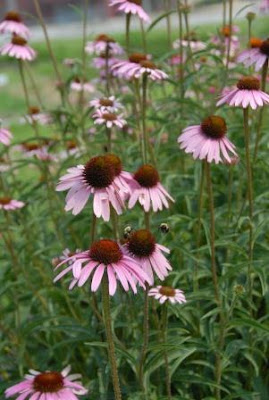Mark spent most of yesterday doing bee yard maintenance. When he got home, he was tired, sore, and bothered. One of the hives at Barhams' Bee Yard appeared to be in great distress and queenless.
Due to other work, he'd not inspected those hives in a month. When he was there 2 weeks ago, he said he noted the bee traffic appeared fine going in and out of all of the hives. He said he'd likely take the porch bees to see if he could save the bees that were left in the struggling hive.
When I got up this morning, he'd been awake since 1:40 a.m., researching. His conclusion: the bees he saw were robbing the hive. He suspects the original hive -- which has been weak all along -- finally gave up, and the other bees are removing the honey from the frames to store for winter.
"The top super had no honey in it at all," he said. "It was dry as a bone."
His plan of action is to leave the hive for a couple more days to see if the bees will rob all of the honey out, then retrieve the entire hive so wax moths don't set up shop. We'll store the empty honey frames in our deep freezer until the spring, when he'll split a strong hive and give it a queen to start a new colony.
So much for bragging we'd made it through the season without any losses.
Wednesday, October 26, 2011
Sunday, October 23, 2011
Making Room for Bees
For my day job, I spend lot of time thinking about agriculture. I am sympathetic to farmers who gamble on the weather, who try to manage everything just right to get the best yield. Their inputs are high, they have little control over many of the circumstances upon which their livelihood depends, and most of the producers I've met are down-to-earth, nice folks who are thoughtful neighbors.
That said, many property owners -- whether farmers, hunters, timber investors, or none of these -- could do so much for pollinators if they would simply make room for them. Wildflowers thrive in the buffer zones, areas between plantings, creek banks, ditches, field margins, and roadsides. Richard at The Peace Bee Farmer writes poetically about the wildflower meadow they planted last year -- just one acre, but it's a haven for all sorts of winged creatures.
Mark is investigating prairie restoration projects for some land he helps manage, which would involve native wildflowers over several acres. I hope it will become a reality, not only because I think some of our bees would be very happy there, but because wild pollinators, who need all the help they can get, would find a beautiful sanctuary.
How can you make room for bees where you are?
That said, many property owners -- whether farmers, hunters, timber investors, or none of these -- could do so much for pollinators if they would simply make room for them. Wildflowers thrive in the buffer zones, areas between plantings, creek banks, ditches, field margins, and roadsides. Richard at The Peace Bee Farmer writes poetically about the wildflower meadow they planted last year -- just one acre, but it's a haven for all sorts of winged creatures.
Mark is investigating prairie restoration projects for some land he helps manage, which would involve native wildflowers over several acres. I hope it will become a reality, not only because I think some of our bees would be very happy there, but because wild pollinators, who need all the help they can get, would find a beautiful sanctuary.
How can you make room for bees where you are?
- if you have unwanted bees in your house or on your property, call a beekeeper, not an exterminator
- plan this winter for your spring pollinator garden
- allow room for wildflowers on the edges of your property
- preserve creek banks by not harvesting timber or planting/harvesting crops all the way to edge. Leave a buffer zone!
- plant a prairie garden (this is from Minnesota) or wildflower meadow (this is for MS)
- take up beekeeping! Seriously, having two hives will bring you a lot of enjoyment. You don't have to be like us and expand from 6 to 22 . . . with plans to go to 50 in the spring.
- lobby for bee-friendly zoning ordinances so people in urban areas can keep bees
- work with your local garden club or school to create a pollinator garden
- plant pollinator-friendly plants -- herbs, flowers, milkweed, etc.
Subscribe to:
Comments (Atom)

